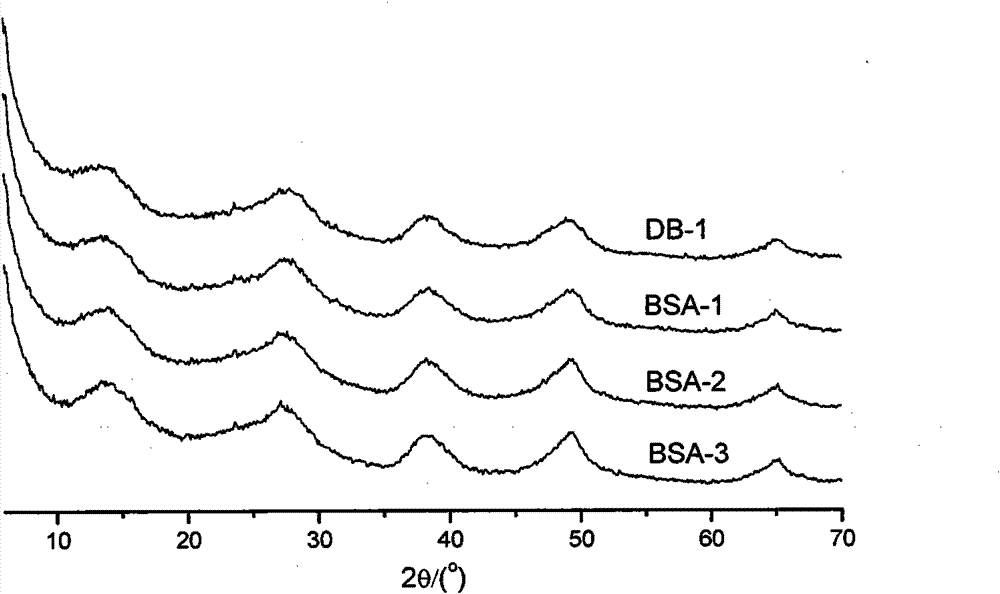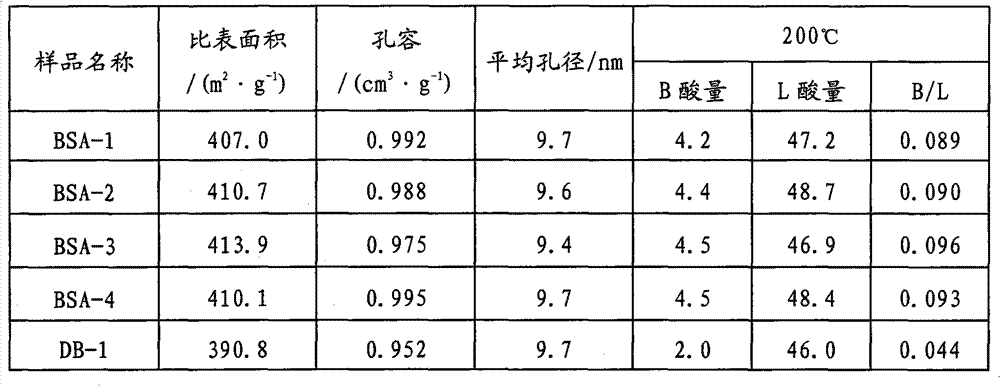Silicon-aluminium catalytic material with pseudo-boehmite crystal structure
A catalytic material, pseudo-boehmite technology, used in catalytic cracking, physical/chemical process catalysts, metal/metal oxide/metal hydroxide catalysts, etc. The problem of uneven distribution of silicon and aluminum, etc., can achieve the effect of good light oil micro-reactivity, obvious pore characteristics, and concentrated pore distribution.
- Summary
- Abstract
- Description
- Claims
- Application Information
AI Technical Summary
Problems solved by technology
Method used
Image
Examples
Embodiment 1
[0019] This example illustrates the preparation of the acidic silica-alumina catalytic material provided by the invention.
[0020] The preparation process of this embodiment is the same as that described in CN1565733A. Take an appropriate concentration of 90gAl 2 o 3 / L Al 2 (SO 4 ) 3The solution is placed in a beaker, and ammonia water is added dropwise under stirring conditions until the system pH = 8, and the neutralization and gelling temperature is 55°C; under stirring conditions, add a quantitative concentration of 60gSiO 2 / L of water glass, heated to 80°C for 2 hours; use NH 4 Cl solution according to precipitate (dry basis): ammonium salt: H 2 O = 1: 0.8: 10 weight ratio, at 60 ° C, carry out ion exchange on the silica-alumina precipitate to remove sodium ions, repeat the exchange twice, each time for 0.5 hours, and then re-beat the obtained filter cake and press fluoro-silicon Acid: Material dry basis: H 2 The weight ratio of O=0.02:1:10, the required fluosi...
Embodiment 2
[0026] This example illustrates the preparation of the acidic silica-alumina catalytic material provided by the invention.
[0027] The preparation process is the same as in Example 1, wherein the addition ratio of fluosilicic acid is fluosilicic acid: material dry basis: H 2 O=0.05:1:10, the acidic silica-alumina catalyst material can be obtained after washing and drying. Recorded as BSA-2.
[0028] The X-ray diffraction spectrum of BSA-2 is shown in figure 1 Middle; crystallinity and elemental analysis chemical composition are listed in Table 1; pore parameters such as specific surface area and infrared acidity data are listed in Table 2.
Embodiment 3
[0030] This example illustrates the preparation of the acidic silica-alumina catalytic material provided by the invention.
[0031] The preparation process is the same as in Example 1, wherein the addition ratio of fluosilicic acid is fluosilicic acid: material dry basis: H 2 O=0.08:1:10, the acidic silica-alumina catalyst material can be obtained after washing and drying. Recorded as BSA-3.
[0032] The X-ray diffraction spectrum of BSA-3 is shown in figure 1 Middle; crystallinity and elemental analysis chemical composition are listed in Table 1; pore parameters such as specific surface area and infrared acidity data are listed in Table 2.
PUM
| Property | Measurement | Unit |
|---|---|---|
| specific surface area | aaaaa | aaaaa |
| pore size | aaaaa | aaaaa |
| specific surface area | aaaaa | aaaaa |
Abstract
Description
Claims
Application Information
 Login to View More
Login to View More - R&D
- Intellectual Property
- Life Sciences
- Materials
- Tech Scout
- Unparalleled Data Quality
- Higher Quality Content
- 60% Fewer Hallucinations
Browse by: Latest US Patents, China's latest patents, Technical Efficacy Thesaurus, Application Domain, Technology Topic, Popular Technical Reports.
© 2025 PatSnap. All rights reserved.Legal|Privacy policy|Modern Slavery Act Transparency Statement|Sitemap|About US| Contact US: help@patsnap.com



